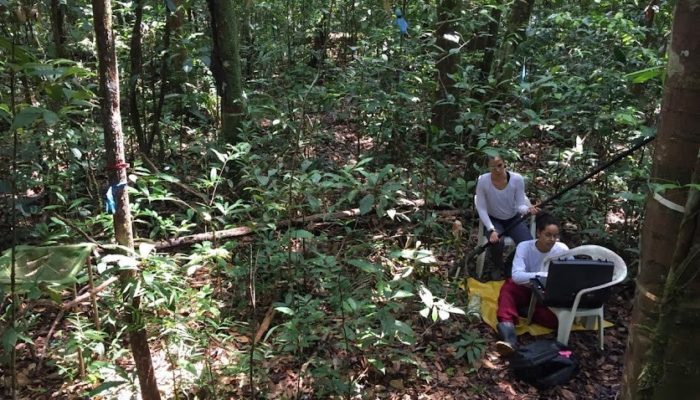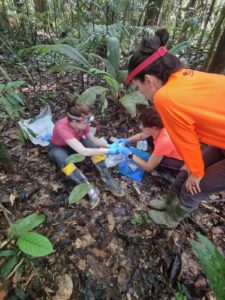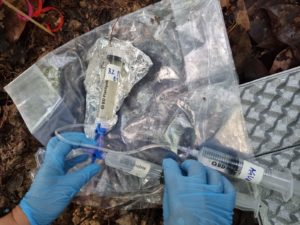
Figure 1. Minirhizotron image acquisition in the field near Manaus, Brazil (photo credit Caroline Miron
From different parts of continental Brazil, now working in different areas of Germany, we, three women scientists, share one more thing in common: our interest in making the hidden importance of the Amazon forest visible. In other words, we are root-nerds!
Studying something that cannot immediately be seen is a challenge per se. When we add the remoteness of some study sites, the mosquitos, thunderstorms, and little access to supplies or electricity, things get a bit more complicated. Nevertheless, we have been disentangling the importance of plant-soil interactions for the past few years, focusing on “hard” traits of fine root dynamics (stocks, productivity, turnover) but also “soft” traits such as root enzyme and organic acid exudation, association with mycorrhizal fungi and root morphology in natural forests and large-scale manipulation experiments.

Figure 2. Animation showing root growth captured using sequential photos from minirhizotron cameras (photo credit Caroline Miron) Click image to see animation!
By understanding how such traits are expressed now and when we manipulate the environment (e.g., Amazon Fertilisation experiment – AFEX and the Free Air CO₂ Enrichment AmazonFACE program near Manaus, Brazil), we could better understand how Amazon forests could respond to changes in climate and soil nutrient access.
One of the approaches we use to shed light (literally) on this shy component of the forest is the minirhizotron technique, which captures the belowground beauty using cameras inside the soil. The diversity of the Amazon plants is reflected in the different colours and shapes of its roots, which also makes the image analysis process tough. After looking at thousands of soil pictures, we saw phenological patterns quite different from what we observe aboveground, pointing to an asynchronous forest functioning. For instance, in the dry season, when leaf production peaks in Central Amazon, fine root productivity is at its lowest. Contrary, in the rainy season, when leaf productivity is low, fine root productivity peaks, potentially caused by increasing organic matter decay and nutrient release in the soil, stimulating root foraging for nutrients.

Figure 3. Installation of root exudation system sampling in situ near Manaus, Brazil (photo credit Tatiana Reichert)
Speaking of nutrients, a big part of our luxurious Amazon forest grows in low-fertility soils, so they invest in different mechanisms to overcome nutrient limitation and maintain their functioning. Since such mechanisms are expensive for the plants in terms of carbon costs, some trade-offs are hypothesised. In June this year, we travelled to Manaus, Brazil, to sample root organic acid exudation in situ. It was strenuous work but also required patience and a lot of care. This was the first time a non-destructive method to sample root exudates was applied in an Amazon forest. These compounds can mobilize the limiting nutrient, phosphorus, from the soil matrix to the soil solution, making it available for plants and microbes.
In a world with increasing atmospheric CO₂ concentrations, understanding if and how plants can supply their nutrient demand and maintain biomass growth is crucial. The more we learn about the interactions among plants, soils, and climate, the more our deep connection with the forests become clear. Knowing more about the complex and entangled root systems of Amazon forests could tell us about how we, humans, can affect essential Earth climate feedbacks.

